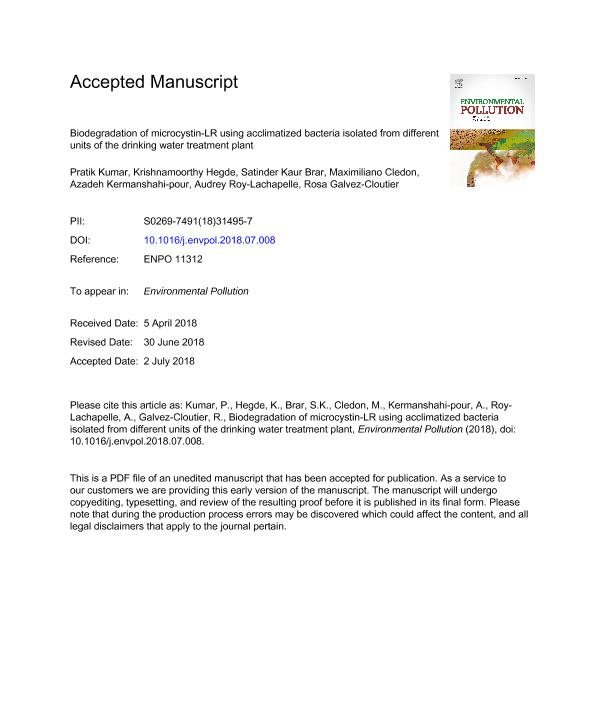Mostrar el registro sencillo del ítem
dc.contributor.author
Kumar, Pratik
dc.contributor.author
Hegde, Krishnamoorthy
dc.contributor.author
Brar, Satinder Kaur

dc.contributor.author
Cledón, Maximiliano

dc.contributor.author
Kermanshahi-pour, Azadeh
dc.contributor.author
Roy-Lachapelle, Audrey
dc.contributor.author
Galvez-Cloutier, Rosa
dc.date.available
2020-03-11T15:33:43Z
dc.date.issued
2018-11
dc.identifier.citation
Kumar, Pratik; Hegde, Krishnamoorthy; Brar, Satinder Kaur; Cledón, Maximiliano; Kermanshahi-pour, Azadeh; et al.; Biodegradation of microcystin-LR using acclimatized bacteria isolated from different units of the drinking water treatment plant; Elsevier; Environmental Pollution; 242; Part A; 11-2018; 407-416
dc.identifier.issn
0269-7491
dc.identifier.uri
http://hdl.handle.net/11336/99125
dc.description.abstract
Bacterial community isolated from different units of a Drinking Water Treatment Plant (DWTP) including pre-ozonation unit (POU), the effluent-sludge mixture of the sedimentation unit (ESSU) and top-sand layer water sample from the filtration unit (TSFU) were acclimatized separately in the microcystin-leucine arginine (MC-LR)-rich environment to evaluate MC-LR biodegradation. Maximum biodegradation efficiency of 97.2 ± 8.7% was achieved by the acclimatized-TSFU bacterial community followed by 72.1 ± 6.4% and 86.2 ± 7.3% by acclimatized-POU and acclimatized-ESSU bacterial community, respectively. Likewise, the non-acclimatized bacterial community showed similar biodegradation efficiency of 71.1 ± 7.37%, 86.7 ± 3.19% and 94.35 ± 10.63% for TSFU, ESSU and POU, respectively, when compared to the acclimatized ones. However, the biodegradation rate increased 1.5-folds for acclimatized versus non-acclimatized conditions. The mass spectrometry studies on MC-LR degradation depicted hydrolytic linearization of cyclic MC-LR along with the formation of small peptide fragments including Adda molecule that is linked to the reduced toxicity (qualitative toxicity analysis). This was further confirmed quantitatively by using Rhizobium meliloti as a bioindicator. The acclimatized-TSFU bacterial community comprised of novel MC-LR degrading strains, Chryseobacterium sp. and Pseudomonas fragi as confirmed by 16S rRNA sequencing. Biodegradation of microcystin-LR by in-situ bacterial community present in the drinking water treatment plant without formation of toxic by-product.
dc.format
application/pdf
dc.language.iso
eng
dc.publisher
Elsevier

dc.rights
info:eu-repo/semantics/openAccess
dc.rights.uri
https://creativecommons.org/licenses/by-nc-nd/2.5/ar/
dc.subject
ACCLIMATIZED BACTERIA
dc.subject
DEGRADATION PATHWAY
dc.subject
DRINKING WATER
dc.subject
MICROCYSTIN
dc.subject
TOXICITY
dc.subject.classification
Biotecnología Medioambiental

dc.subject.classification
Biotecnología del Medio Ambiente

dc.subject.classification
INGENIERÍAS Y TECNOLOGÍAS

dc.title
Biodegradation of microcystin-LR using acclimatized bacteria isolated from different units of the drinking water treatment plant
dc.type
info:eu-repo/semantics/article
dc.type
info:ar-repo/semantics/artículo
dc.type
info:eu-repo/semantics/publishedVersion
dc.date.updated
2020-02-18T16:05:25Z
dc.journal.volume
242
dc.journal.number
Part A
dc.journal.pagination
407-416
dc.journal.pais
Países Bajos

dc.journal.ciudad
Amsterdam
dc.description.fil
Fil: Kumar, Pratik. Université du Québec a Montreal; Canadá
dc.description.fil
Fil: Hegde, Krishnamoorthy. Université du Québec a Montreal; Canadá
dc.description.fil
Fil: Brar, Satinder Kaur. Université du Québec a Montreal; Canadá
dc.description.fil
Fil: Cledón, Maximiliano. Universidad Nacional del Comahue; Argentina. Consejo Nacional de Investigaciones Científicas y Técnicas; Argentina
dc.description.fil
Fil: Kermanshahi-pour, Azadeh. Dalhousie University Halifax; Canadá
dc.description.fil
Fil: Roy-Lachapelle, Audrey. University of Montreal; Canadá
dc.description.fil
Fil: Galvez-Cloutier, Rosa. Laval University; Canadá
dc.journal.title
Environmental Pollution

dc.relation.alternativeid
info:eu-repo/semantics/altIdentifier/doi/http://dx.doi.org/10.1016/j.envpol.2018.07.008
dc.relation.alternativeid
info:eu-repo/semantics/altIdentifier/url/https://www.sciencedirect.com/science/article/pii/S0269749118314957
Archivos asociados
